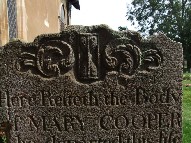| |
|
| |
|
 |
|
Trimley is a
western suburb of Felixstowe, a low drama
of modern housing stretched along the
former A45. It is still dignified by two
parish names (there used to be three, but
Alston, also known as Trimley St John,
was subsumed by the others some 400 years
ago). The churches of St Martin and St Mary sit in the same graveyard.
Coming here ten years ago, I mused on the
reasons why such a busy place might not
have a very big congregation in its
Anglican parish church. I observed that
one might imagine St Martin a thriving
community, but the situation here had
proved rather curious. Felixstowe itself
has five parish churches, including the
Suffolk Anglo-catholic flagship of St
John the Baptist, and what was then the
famously and militantly protestant St
Andrew. There
is also the vast edifice of Cavendish
Community Church, now renamed Christ
Church the county's biggest evangelical
project. Adjacent Walton has another
church of evangelical tendencies, and
Trimley itself has several other
churches, including the lively Catholic
church of St Cecilia, and the popular
Trimley Free Church. So, you begin to
feel the squeeze. It was inevitable that
at least one of the Trimley churches
would become redundant, but in the end
this did not happen, the joint parish
prefering to successfully reinvent St Mary as a community facility, St
Martin remaining as the parish church.
|
St Martin is one of several
churches in this immediate area dedicated to the
former Bishop of Tours. Across the graveyard, St
Mary is now a
multi-purpose building; the two buildings are not
dissimilar, although St Martin was obviously
ahead in the queue when the towers were handed
out. St Martin is more apparently 19th century
than its partner, although in fact very little
remains of either building that is openly
medieval. Something that both churches have in
common is that they are both ordinarily kept
locked without a keyholder notice.
Back in 1999, my reason for
musing on the parish life of Trimley was that the
interior of St Martin had been reordered, with
modern chairs turned in an arc to face an altar
set against the south wall beneath a rather
alarming war memorial window. At the time, the
churchwarden had explained to me that it was
cosier this way. "There aren't very many of
us, I'm afraid", she'd observed sadly.
Coming back here in 2008, I had a rather curious
experience at the next door church of St
Mary, which you can
read about there, but it resulted in us being
allowed to see inside St Martin as well. What a
change there had been, for the integrity of the
interior had been restored, with the chairs
turned to face the sanctuary in the east. The new
churchwarden told us that the parish was now so
busy that this was the only way of fitting
everyone in, which was heartwarming to hear.
| As with St Mary,
this church is notable for its late 19th
and early 20th Century glass, and
although it isn't quite as good as that
in the church next door, The best of all
is here in the north aisle, the former
Cavendish chantry, and depicts a highly
original and inventive Resurrection
scene. Sam Mortlock tells me that he has
been unable to identify the artist,
although the signature appears to be CAH,
and it probably dates from the 1940s. Trimely's
most famous window depicts Christ as a
crucified king attended by an airman, a
sailor and a soldier, and forms the
parish's World War Two memorial. I think
it is rather bizzare, I must say, but it
is the stuff out of which postcards are
made, or were, in the days when people
still sent and collected them. The
workshop was the splendidly named Hendra
& Harper of Harpenden, and the Hs of
their signature are set into the foot of
the window. All in all, an interior well
worth seeing. But if you can't get
inside, there is a super collection of
17th and 18th century gravestones in the
churchyard outside.
|
|
 |
|
|
|
Simon Knott, November 2008

  
 
   
   
Amazon commission helps cover the running costs of this
site.
|
|
|

